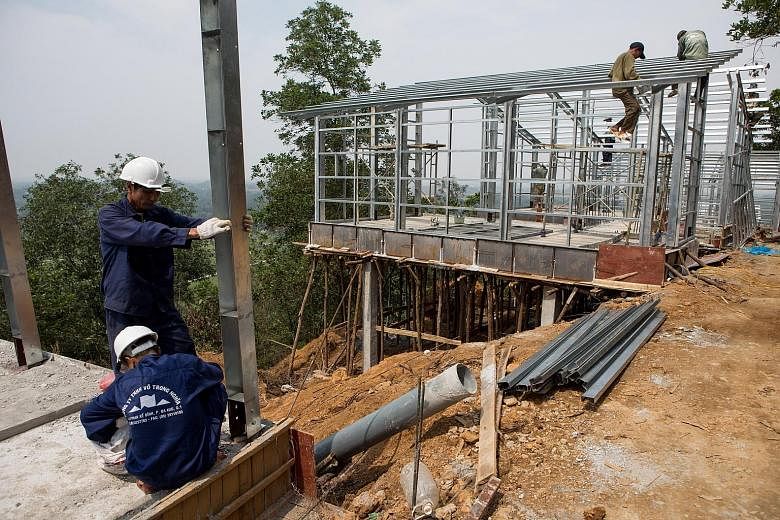BA VI (Vietnam) • Just below a hilltop pagoda, steel frames the size of two car garages were popping up on a bluff that overlooked a valley of electric-green rice paddies.
They were prefabricated homes designed by Vietnamese architect Vo Trong Nghia and the construction team said it was impressed by the speed of its own handiwork: nearly one frame hoisted each hour and largely without power tools.
"Looks like Lego and it's easy to install," said project supervisor Nguyen Duc Trung.
It is far cheaper too: a small fraction of the US$35,000 (S$48,200) Le Van Dung, one of the workers, said it would cost to build a home in his northern Vietnamese village.
Known as "S Houses", these prefabricated structures going up in Ba Vi, about 50km from Vietnam's capital, Hanoi, are iterations of a prototype that Nghia has been honing since about 2013. They will serve as the living quarters for a new Buddhist meditation centre.
But Nghia says his plan is to mass-manufacture this portable, easy-to-assemble design for people in slums, remote areas or refugee camps around the world, beginning later this year, all for US$1,500 - the starting price of about two iPhones.
"We architects always do designs for clients with lots of money, but there are a lot of needs" in poor communities as well, said Nghia, whose work often transposes Japanese- style minimalism to a South-east Asian context. His staff is fielding preliminary inquiries from prospective buyers as far away as Nigeria, Vanuatu and Syria.
Nghia, 40, said the S House was designed to last at least 30 years and to withstand severe tropical storms such as the ones his "super poor" family once experienced in their central Vietnamese farming village.
He is the latest high-profile architect to design an inexpensive, prefabricated home as an antidote to urban sprawl, mass displacement or natural disasters.
Experts say the S House is one of several "humanitarian" or "social" architecture projects worldwide that highlight a rising social consciousness in the profession at a moment when the estimated number of displaced people worldwide - 65.6 million last year - is the highest since the aftermath of World War II.
Some of these projects are recognised as much for their form as their function. Japanese architect Shigeru Ban designed shelters from recyclable paper tubes for victims of violence and natural disasters, for example, while Chilean architect Alejandro Aravena has pioneered what he calls "incremental" social housing projects, in which residents buy half of a two-storey home at a state-subsidised rate and complete it when and how they can.
Some critics say, however, that high-profile humanitarian architecture often ignores the complexities of housing policy and finance, as well as local variations in climate, building materials and aesthetic tastes.
Assistant professor of architecture Chang Jiat Hwee at the National University of Singapore said the notion of using prefabricated dwellings to solve housing problems in the global South was pioneered by Europeans in the 19th century and became especially prevalent in the 1950s.
But the projects have tended to fail, he added, because they took a universalist approach that ignored local particulars.
Nghia said the S House would fit different environments, in part because its frame can be purchased alone and clad in whatever local materials are available. A full package would cost between US$2,000 and US$3,000 and include steel-lattice walls and a corrugated roof.
It is suitable for remote areas because no single component weighs more than 50kg, he said, and its design could also be modified to suit local conditions - higher ceilings for hotter climates, for example.
He planned to scale up production to meet whatever demand materialises and he would offer to sell S Houses to the United Nations, at cost, as refugee shelters. (The S stands for "strong, sustainable and steel".)
Meanwhile, he would be watching to see how the 38 new S Houses in Ba Vi hold up during their first test: an eight-week silent meditation course that he planned to attend.
Each house will have a thatch roof, four beds and no air-conditioning. "I'll know what the problems are" after so much time for reflection, he said with a laugh. "But I believe it will be really comfortable."
NYTIMES

